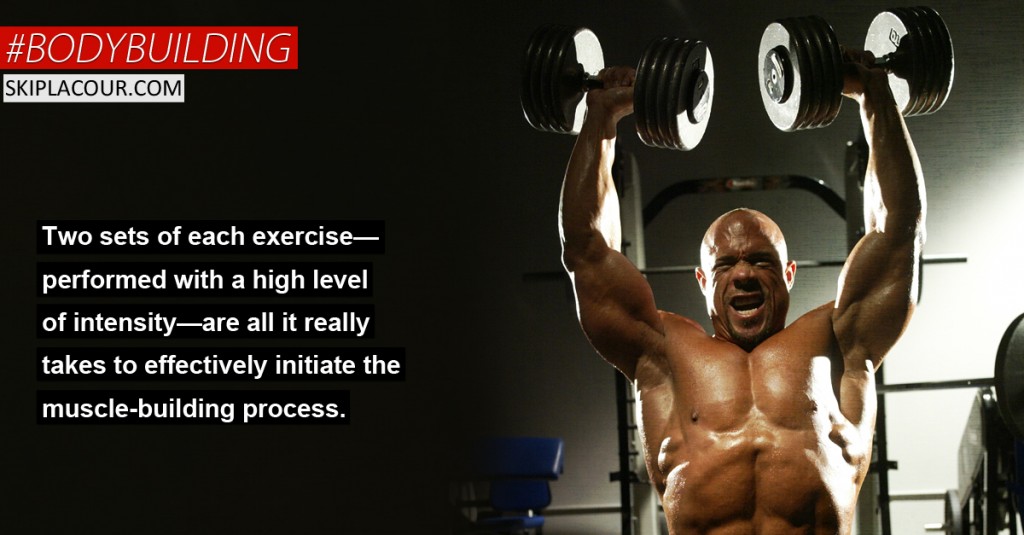Two sets of each exercise—performed with a high level of intensity—are all it really takes to effectively initiate the muscle-building process. On occasion, I will allow three sets to get the job done—but any more than three sets simply is not necessary. Just like many other bodybuilders, I used to perform four to five sets of every single exercise when I first started training years ago. Why did I choose four to five sets? To tell you the truth, I don’t really remember. More than likely, the reason why I settled on that amount was because the first person I started training with in the gym years ago passed along that philosophy. Doing four sets; for four or five different exercises; for every body part must be written in the “Unofficial Beginner’s Bodybuilding Handbook” somewhere, don’t you think? We all seem to have trained that way when we first started working out. Many people still do.
Have you ever noticed that, when you get yourself in the focused, “training warrior” mindset, you always seem to pump-out significantly more reps during the last of your four sets than you do during the first one? Let me explain why doing four sets of every exercise is not an efficient way to train. Let’s just say you plan on doing four sets of a particular exercise. During each set of that exercise, your goal is to get at least eight repetitions. On the first set, you get eight reps—exactly as you had planned. While performing the second set, you will usually get all eight reps again. During the third set, you tend to squeak out all eight reps as well. Getting all of those reps during the third set may have been a bit more challenging than the first two sets. But, despite the difficulty, you were mentally tough and managed to meet your rep range goal. If you do happen to get any more than eight reps during any of those first three sets, you more than likely won’t get many more than one or two in addition to the eight. This is how I would describe my training performance in the past. No matter what exercise I was doing or which body part I was training, it always seemed to work out that way. Hasn’t this been true in your case as well?

But isn’t it strange that, when you know you only have one set remaining of a particular exercise, your mindset changes? You can mysteriously muster up incredible strength and produce three, four, or even five more reps for an amazing total of 13! All of a sudden, you really became a training warrior. You’ve instantly transformed into a determined, machine-like madman who would make Dorian Yates (my role model for training intensity) envious! If you think about it, don’t you believe your performance should have turned out just the opposite? Let me explain what I mean: If you were really giving your all like you thought you were during the first three sets, there shouldn’t be nearly as much energy and power left to meet—much less exceed—that goal of eight reps during the last set. There simply shouldn’t be that much physical strength left inside of you by that time. If you were truly training with the utmost intensity (like we all think we do—myself included) you probably should have gotten about 12 repetitions during the first set; somewhere around 10 reps during the second one; eight or nine during the third one; and maybe only about six during the fourth one.
I urge you to cut to the chase, eliminate the excess fat, get rid of the garbage sets—and start training like Dorian Yates would during every set—during the entire workout! You must ignite a sense of urgency in order to train with the highest level of intensity. Planning to do only one, two, and sometimes three sets creates that sense of urgency you need. Oftentimes during my workouts, I implement what I call, “one-hit-wonders”. One-hit-wonders are exercises that include only one set. Giving yourself only one chance with a particular exercise creates a sense of urgency that ignites the intensity of your training. One-hit-wonders make your training similar to a shot-out-of-cannon sprint rather than a lingering, long-lasting marathon. This is a good mental habit to get in while training just as much as it is a good physical one.

Many lifters give themselves four and five sets of a particular exercise to get the job done. If you give yourself four or five chances to do anything, undoubtedly there will be less importance, less of a demand, or less of a sense of urgency to give as much effort as you really can during the first couple of sets. It’s only human nature for us to think that way under those conditions. In order for us to perform at our highest level of performance, we must change those less-than-ideal mental conditions.
If you really train like a workout animal, then you can indeed effectively build muscle doing fewer sets. If you train like, let’s say “less than an animal” then you’ll probably need more sets to make your workouts just as productive. Anything less than 100 percent effort during a set is a wasted set in my opinion. I can’t tell you exactly how many sets you should use to train each of your body parts effectively—and neither can anyone else. It all depends on that ever-evolving, ever-changing, constantly re-defining level of intensity.

